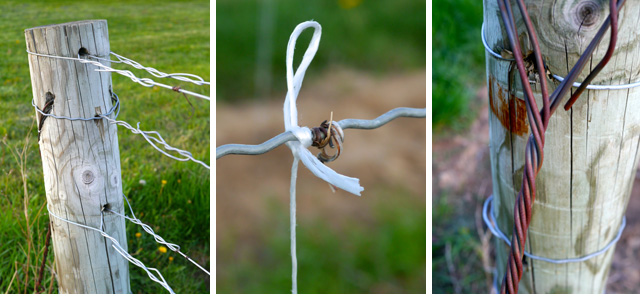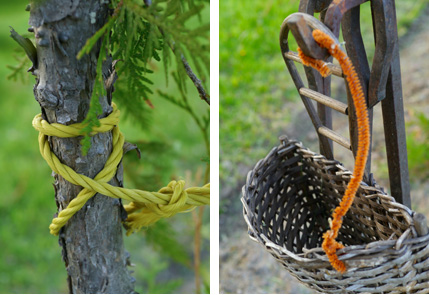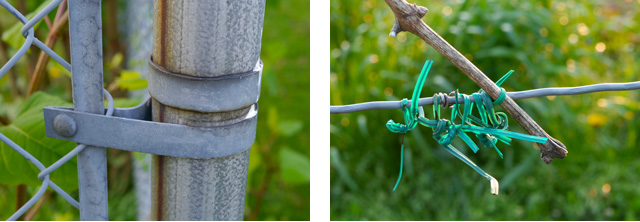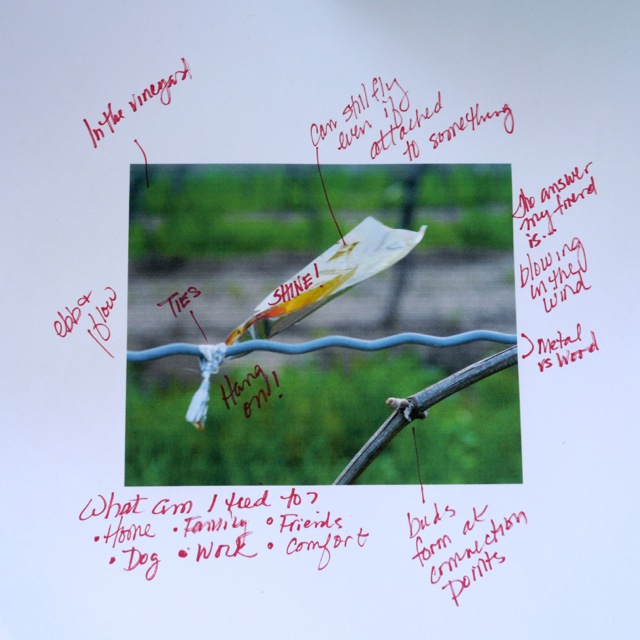For the next little while, I’m reposting content from my archive that I think is relevant for today. In 2014, I launched a course in visual journaling with Sally Gentle Drew. It’s now available as an on-demand course. Below is the post that introduced the course.
I’ve never been a consistent journal writer; I probably have 15 barely started journals at my home, which I usually end up filling with notes or quotes from books I’m reading. The truth is, writing is often a struggle for me, even though I write a blog post every week and a newsletter every other week.
Hence – visual journaling as a practice.
I firmly believe that what we’re drawn to photograph reflects our inner world. If we take the time to contemplate our favourite photos (our own or others), they’ll reveal something about us. When I first moved to Niagara-on-the-Lake and began to explore this new place, I found myself drawn to vines on walls and blossoms at my feet. Both had meaning for me, as I was returning to the area of my birth (my mother’s maiden name was Vine), I was making new connections and re-visiting old ones. I felt very lucky to be in this beautiful place.
Later, I was talking about contemplative photography with a group of women who were new to the idea. After getting into an open and present state of mind, we went out for a contemplative photo walk. The purpose was to notice what we were drawn to and photograph that – not to worry about what would make a “good” picture. I found myself very clearly drawn to “ties that bind.”
All of these images were taken within a half hour time frame. Very rarely does a specific theme appear so clearly, so I definitely paid attention. In reflecting on the common theme of “ties that bind” I came up with the following:
* The strong ties/connections (friendships and family) that I have that are very important to me and are being redefined.
* Sometimes I feel tied down due to lack of transportation and dog responsibilities.
* Strength is found at the connection points.
* Ties provide some protection from external forces.
I took one of the images, printed it out, and wrote out my thoughts on what it said to me.
Visual journalling can be a powerful tool for self-discovery.
Images for Visual Journalling
* Yours or someone else’s
* Favourites over the course of a period of time
* A theme or pattern that’s been emerging in your photography, i.e. subject, topic, colour, perspective, genre
Print out an image or group of images on plain paper (with room to write on).
Questions to Ask
* What words come to mind as you look at the image(s)?
* Name the qualities that are present in the image(s), i.e. softness, dramatic contrast, simplicity, monochromatic, etc.
* Do the images tell a story? Does the story reflect something going on in your own life?
* Is there a message for you in the images(s)?
If you’re interested in doing more visual journaling, please go to this page to learn about an on-demand visual journaling workshop available for you.
Other Resources
Patricia Turner’s wonderful “Field Guide for the Contemplative Photographer” is available as a free download from my site. In it, she quotes John O’Donohue as saying, “The outer landscape becomes a metaphor for the unknown inner landscape.” Turner offers practices in the field for visual listening, sketching, and journalling. Download it here.
Eyes of the Heart: Photography as a Christian Contemplative Practice by Christine Valters Paintner. This is a wonderful book, particularly if you come from a Christian perspective (although valuable even if you’re not). It speaks of photography as an encounter with sacred presence and offers a reflective practice called “visio divina” or sacred seeing with the heart. Christine sees art as “a process of healing and transformation.”
Susannah Conway offers online courses on Journalling and Photography as Meditation. I’ve taken both and highly recommend them.




I love this post, Kim, thank you. I am so intrigued by metaphor and the abstract symbolic messages that show up in our lives. I love playing with my camera and, more and more, I feel the urge to see what it has to teach me. Perfect timing. I love it when the universe conspires to give me exactly what I need in the moment. The line I am going to savor in this beautiful post is this: “Strength is found at the connection points.” I’ll let you know what shows up.
I loved this post and the ties that bind.. I can relate.
Visual journalling is a wonderful idea, Kim. I really liked the way you added your thoughts and feelings around the photo you had taken. The words “ebb and flow” speak to me. I’m going to try this idea as I can see similar subjects cropping up in my photography which obviously have subtle messages for me.
This series is quite stunning – even more so because it was taken on a single walk, over a short period of time – what a gift!
And looking at it from the receiving end – I find it amazing that you have a difficult time with writing – your pieces are always so informative and well-written. You certainly have a talent for it. Maybe it is those things that we struggle with, that we fight for, that end up having the most meaning.
Kim, I’ve just spent the last hour ‘with you’ and I think you are a Kindred Spirit. I found you the other day thru Lisa Redwillow, who is in a Kim Klassen class with me.
You manage to articulate what is in my heart – and in so doing, have helped me understand just why I am the way I am (compulsively creative) and why I should bother to create at all. One more step on this spiritual/creative journey.
God bless you!
xoxo
Oh, I love when that happens. That’s why I’m here – to find kindred spirits. Thank you for spending time with me.
I would love to experiment with this and see if a practice of regular visual journalling could result in a vision board of sorts. The language of the universe is pictures (I read that this week, maybe Jamie
Ridler?). This is an exciting idea.
After seeing you tonight I feel inspired to do some camera play.
I am sitting here, chin on hand, trying to find words for my thoughts… my husband walks in ‘are you contemplating?’ he says. Spot on! 🙂
Let me say this, there is nothing quite as exciting for me as connecting with someone else’s contemplative photo; with your photos I connect instantly! No words needed! xx
I’m so glad and I agree it is exciting for me too.